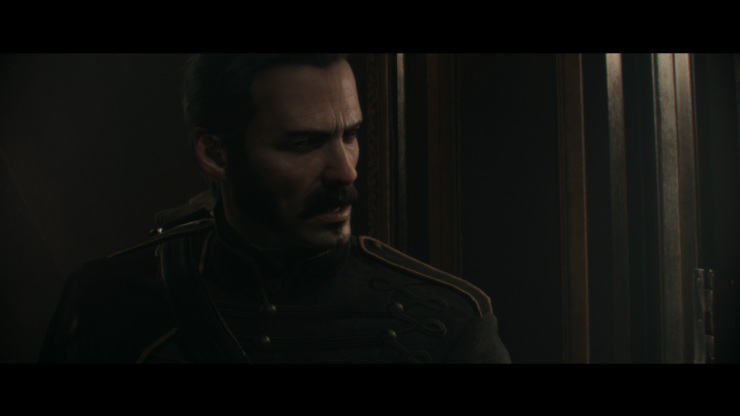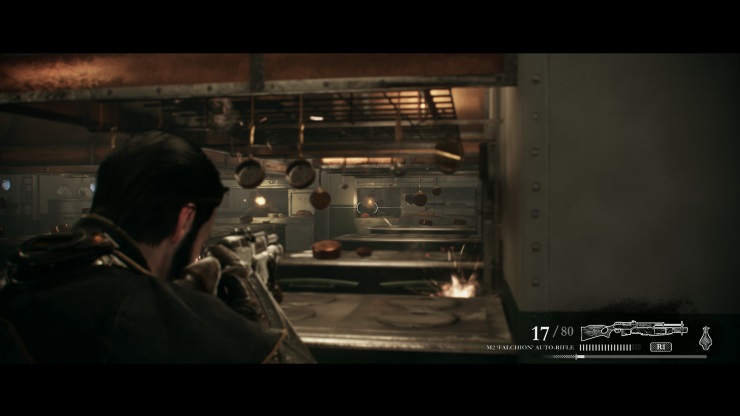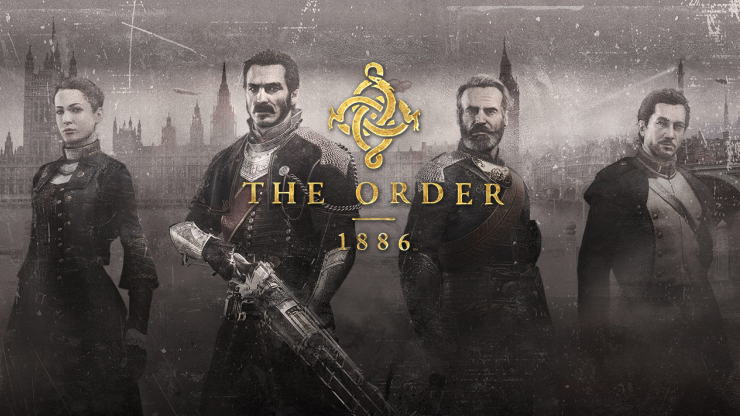British history, as a general rule, is pretty interesting. From the ancient days when we were a bunch of mucky tribesmen resisting the bloody Romans through the Tudors and Stewarts, the Gunpowder Plot, the Great Fire of London and the Battle of Britain, we’ve been around for ages, and we’ve had our share of wars and tragedies and enough in-fighting and political intrigue to rival a series of Game of Thrones. And yet it’s still not interesting enough, according to Ready at Dawn, without throwing in giant airships, werewolves, vampires and retro-futuristic technology. Their new shooter, The Order: 1886, delivers all those apparently missing components, and then some.
A PS4 exclusive announced at the same time as the console, The Order follows a group of Knights in an alternate history London where they defend humanity from all manner of evil, human and otherwise. Protagonist Galahad is a senior Knight in the elite outfit, adept in stealth, combat and The Order’s steampunk version of hacking. Mixing third-person shooting with a heavy dose of quick time events, The Order attempts to blur the line between video game and interactive movie and, depending largely on your opinion of QTEs, mostly succeeds.

The segment I played was fairly short, ending rather abruptly after just under an hour, but in that time I got to sample a decent cross-section of mechanics. Beginning in the skies above London, Grayson (or Galahad, as he is known in the Order), grizzly mentor Sebastian “Percival” Mallory, French upstart LaFayette and apprentice Isabeau “Igraine” D’Argyll are called upon to abseil down the side of a huge airship (it’s not a steampunk retro-future without an airship, right?), in an attempt to rescue an important dignitary from a band of rebels. Story details are thin on the ground at this point and the preview filled in no blanks; this segment came from around mission 5 when all the early game spoilers are over with. I didn’t know why I was rescuing the target, who the enemies were or how the mutated beasties from the early trailers would fit in, but within approximately five seconds I’d forgotten to care. The Order: 1886 is utterly, breathtakingly beautiful.
I don’t mean beautiful like a child’s laugh or the first fallen leaves of Autumn, I mean drop dead gorgeous like you read about. Gameplay looks for all the world like an interactive cutscene and the level of detail is extraordinary. Even having seen Far Cry 4, Alien Isolation and Assassin’s Creed: Unity, arguably the best examples of current gen graphics available, I was blown away by the aesthetics. The cloth and hair physics, shadowing and dialogue animations are astounding. Putting gameplay aside for a moment and focusing purely on the skin-deep, The Order: 1886 is a glimpse into the future of console gaming, a teaser of what’s to come when developers really start to push the hardware.

It is, of course, mostly surface shine. For such a rich and detailed world, The Order’s airship was curiously barren of life. Desks may appear strewn with papers, the corners seem stuffed with rubbish and discarded tools, and the grime on the walls might well give the impression of years of negligence, but everything is a static block, a prop that you can neither interact with or even permanently damage despite the high-powered machine gun in your hands. At one point I took cover behind a flimsy balcony rail during a firefight expecting to have to move, a worry exacerbated by the sounds of splintering wood as the enemy guards unloaded at me – but I didn’t have to move at all. I just kept my head down behind two inches of apparently bullet-proof wood. Likewise, I really wanted to leap the balcony and get into the thick of the fight, but instead I had to find a flight of stairs and walk down like some chump.
Initially I was forced to move stealthily through the bowels of the airship as LaFayette and I made our way to the cockpit. The camera, rather deliberately, creates a claustrophobic feeling in this confined space, positioned right above Galahad’s shoulder, meaning you can only really see what he can for the most part. It’s an effective trick to create atmosphere, but it’s not all that pleasant a viewpoint. There was a definite sense that if only the camera would pull back a little, it would all be much more enjoyable. It wasn’t long before I had to hack a junction box for reasons that weren’t exactly explicit, and was presented with a decent little mini-game where I had to stop two bouncing pins between a pair of needles by clicking the left and right sticks. There’s also a rumble-pad sensitivity minigame similar to Skyrim’s for picking locks.

During this section I came upon a hapless guard who was unfortunate enough to be looking the wrong way. My first attempt at a stealth kill failed, however, as I hit Triangle to soon. The icon flashed red and he whirled around and shot me twice in the chest. Failure here is rewarded with insta-death, dropping you back to the last checkpoint. Sometimes that might be round the corner, sometimes it’s much further away. The distance doesn’t seem to be particularly consistent, which may become irritating. Heading back in, I took my time, waited for the icon to flash, and delivered a brutal stealth kill with Galahad’s ridiculously oversized dagger. In keeping with the apparently linear, funnelled nature of the game design, you can’t move a body and must instead hope no one wanders past and spots it. This is a shame, as there are places everywhere that a body would fit snugly into.
After stepping over the unlucky lackey, I spotted the cockpit up ahead. A press of Triangle segued into a cutscene in which LaFayette and Galahad stormed the pilot’s box, introducing the first of several quick time events. Square to hit a charging guard in the misters, Triangle to smash a face into a console full of 19th Century LEDs and then a brief fumble to line up the Triangle icon with a spot on the screen that finished off the last assailant. It was all gloriously cinematic, but made me wonder why I couldn’t just have timed my counter attacks to deliver a context-sensitive ass-whooping, a la Uncharted or Shadow of Mordor.

From the cockpit I made my way to an aristocrat’s lounge, wherein a gunfight soon ensued with me leaning against the aforementioned balcony with a sniper rifle. Circle slams you into cover and allows you to switch vantage points, while the D-Pad takes care of cycling weapons. Galahad can carry a two-handed gun (rifle, shotgun or machine gun) and a pistol, and holds smoke and frag grenades. It’s more satisfying to simply get close to enemies and take them down with a press of Triangle, but the shooting is excellent in of itself. Guns have noticeable impact and sliding into cover is fluid and immediate.
If The Order: 1886 is going to suffer, it will be due to concessions made to facilitate those amazing visuals. Where other games are working hard to make their worlds feel vibrant and alive, and the technology exists to put players in even greater control of their avatar’s actions than ever before, a game that relies so heavily on single button QTEs will feel like a step back for some. By now we’re almost used to seeing destructible scenery and movable corpses, and their absence here makes them conspicuous. That said, what The Order does, it does wonderfully well, cutting cinematic set-pieces with solid combat and a brilliantly-realised atmosphere.
With no real idea yet how the supernatural elements will link story to gameplay and vice-versa, and with little insight into characterisation or plot, all I can base my opinion on is what I’ve played, and what I’ve played impressed me. The Order: 1886 is unlikely to be a ground-breaking revelation, but what it almost certainly will present is a magic mirror into the future of cinematic action games, where the stark segue between cutscene and gameplay is a thing of the past. We’ve yet to see just how balanced it will turn out to be at launch, but in this early guise The Order: 1886 is beautiful, brutal and engaging.





